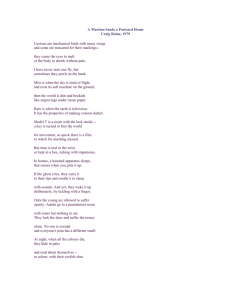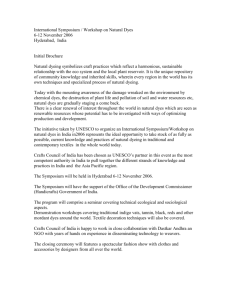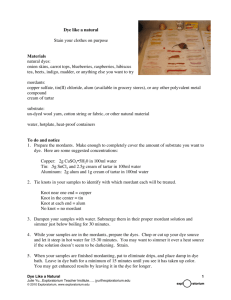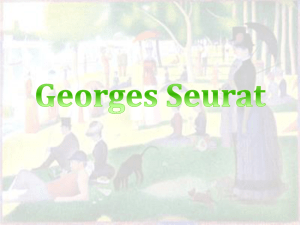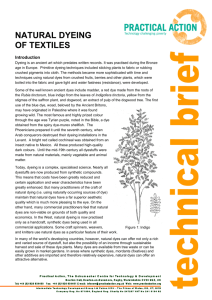Part I: Plant Extracts as Homemade Indicators Principle
advertisement
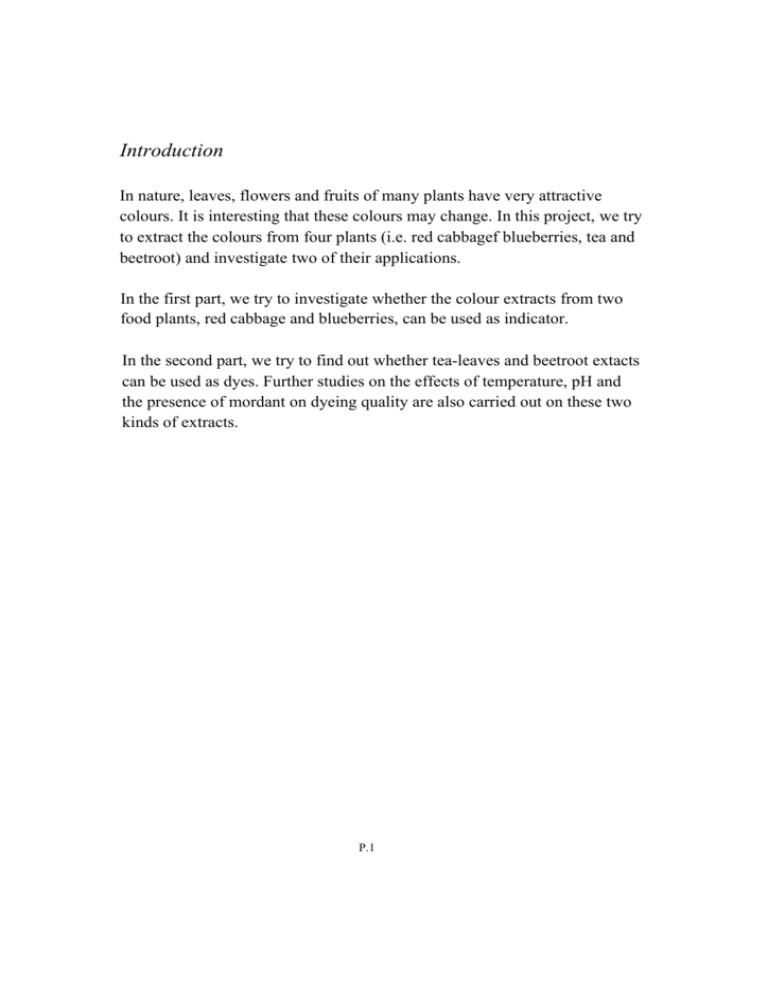
Introduction In nature, leaves, flowers and fruits of many plants have very attractive colours. It is interesting that these colours may change. In this project, we try to extract the colours from four plants (i.e. red cabbagef blueberries, tea and beetroot) and investigate two of their applications. In the first part, we try to investigate whether the colour extracts from two food plants, red cabbage and blueberries, can be used as indicator. In the second part, we try to find out whether tea-leaves and beetroot extacts can be used as dyes. Further studies on the effects of temperature, pH and the presence of mordant on dyeing quality are also carried out on these two kinds of extracts. P.1 Part I: Plant Extracts as Homemade Indicators Principle Acid-base indicators are substances which appear as characteristic colours in different pH. They are usually weak organic acids or bases which have different colours in their ionized form and non-ionized form. In aqueous solution, the two forms of the indicator are in equilibrium. H+(aq) + In-(aq) ionized base form HIn (aq) non-ionized acid form In an acidic solution, the equilibrium shifts to the left and the colour of the indicator is mainly the colour of the non-ionized form. In alkaline solution, the equilibrium shifts to the right and the colour of the ionized form predominates. As we suspected that some colour pigments in red cabbage and blueberries might change colours with pH, we added the plant extracts into solutions with different pH to investigate the possibility of using them as indicators. The investigation The plant extracts were prepared by boiling the plant in a suitable solvent (distilled water for red cabbage and ethanol for blueberries). Solutions with pH 1 - 14 were prepared. Then 5 drops of the plant extract were added to the solutions with different pH. The two sets of colours obtained by using red cabbage and blueberry extracts were observed and compared. P.2 Result Blueberries as indicator pH range colour 1-3 pink 4-9 nearly colourless 10-14 brownish green Red cabbage as indicator pH range 1 2-3 4-6 7-9 10 11 12-14 colour deep red reddish purple pale violet blue green yellowish green yellow Discussion As both extracts changed colours with pH, they could be used as acid-base indicators. But of course red cabbage extract, which gave more colours, worked better and had a wider field of application. The indicators we used are natural. They are all non-hazardous and they can be prepared easily. These advantages make both red cabbage and blueberry extracts decent teaching materials for junior form students. But both plant extracts cannot be stored for a long time and they are not suitable for precise pH measurement. P.3 Part II Plant Extracts as Dyes Principle Dyeing is an adsorption phenomenon and there are three essential components needed for dyeing namely a pigment, a solvent and a mordant, which binds colours on cloths. In the project, colour extracts form beetroot and tealeaves are sources of pigments; ethanol and water are used as solvents and alum is chosen as the mordant. We immerse cloths into dyes kept at different temperatures, pH, with or without alum to find out how the three factors affect dyeing quality. The result of dyeing is studied by soaking the dyed cloth in distilled water for 15 minutes and then comparing the intensity of the colours of the cloths before and after soaking. The Investigation Beetroot and tea-leave extracts were prepared and some cleaned cloths were boiled in alum solution. To investigate the effect of temperature, dyeing solutions were kept at 0oC, 30oC,60oC and 80oC. Cloths were then added and dyed for 15 minutes. For the effect of pH, cloths were immersed into dyes containing hydrochloric acid, distilled water or sodium hydroxide solution. For the factor of mordant, ordinary cloths and those soaked in alum solution were used for dyeing. After the dyed cloths had been dried, they were soaked in distilled water for 15 minutes. Results Dye Optimal conditions for dyeing Temperature pH medium With or without alum Beetroot o 30 C Neutral (distilled water) With alum Tea-leaves o Neutral (distilled water) With alum 60 C P.4 Discussion According to our results, every dye had its own optimal temperature range for dyeing. In both cases, extreme temperatures had adverse effects on dyeing, for example, beetroot extract changed from pink to brown at 80oC. For both beetroot and tea-leave extracts, the best dyeing quality was given when distilled water was added to the dyeing solution. The dyeing quality, especially the ability to retain colour, was greatly improved with the use of mordant. This matches a mordant's function to bind colours on cloths There are limitations on the uses of natural plant dyes because the dyes may be degraded by light and heat. Nevertheless, natural dyes have some advantages over artificial dyes. Natural dyes are non-allergic and they are more suitable for children and babies. They are also less likely to cause hazards to health. Moreover, they are biodegradable and pose less pollution problems. To conclude, the pigments used gave quite attractive colours. However, further research has to be carried out before they can be used as dyes in real life. P.5 -End-




